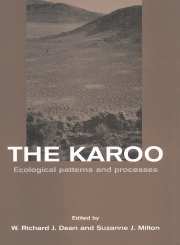Book contents
- Frontmatter
- Contents
- List of contributors
- Foreword
- Preface
- Acknowledgements
- Part one Biogeographic patterns and the driving variables
- Part two Form and function
- Part three Dynamics
- Part four Human impacts
- 15 Hunters and herders in the karoo landscape
- 16 Historical and contemporary land use and the desertification of the karoo
- 17 Alien plant invaders of the karoo: attributes, impacts and control
- Part five Comparisons
- References
- Index
15 - Hunters and herders in the karoo landscape
Published online by Cambridge University Press: 23 December 2009
- Frontmatter
- Contents
- List of contributors
- Foreword
- Preface
- Acknowledgements
- Part one Biogeographic patterns and the driving variables
- Part two Form and function
- Part three Dynamics
- Part four Human impacts
- 15 Hunters and herders in the karoo landscape
- 16 Historical and contemporary land use and the desertification of the karoo
- 17 Alien plant invaders of the karoo: attributes, impacts and control
- Part five Comparisons
- References
- Index
Summary
Introduction
When the first trekboers moved into the karoo in the eighteenth century they were entering an environment that had already been impacted by human use for over three million years. While the impact would have been minimal for most of this time, increasing skills in modifying and manipulating the environment, such as driving game with fire, meant that humans played a greater and greater role in the distribution of plants and animals. Sampson (1986) has noted that around prehistoric hunter campsites in the karoo surface erosion is evident, and alterations have occurred to plant communities. The latter was evident in the consistent growth of Lycium sp. on sites, as well as seasonal growth of Arctotheca calendula, Salvia verbenaca, Oxalis depressa and Ifloga paronychioides, all of which are considered to be weeds. According to Sampson (1986: 41) this damage amounts to 5.6% of the rangeland (excluding dolerite ridges and hills). The greatest damage would have been around important resource loci, such as waterholes.
Human adaptation to arid lands
While the karoo appears to be a dry and difficult environment today, and would have possibly been even more so without underground water being available, in the past this was not a stumbling-block to human habitation. People knew where water was to be found, even if they had to dig in dry river beds or for underground water-bearing plants to get it. Water is the least available necessity, so presumably controlled to a considerable extent where people would have been found before underground aquifers were tapped by wind-driven pumps at the end of the nineteenth century.
- Type
- Chapter
- Information
- The KarooEcological Patterns and Processes, pp. 243 - 256Publisher: Cambridge University PressPrint publication year: 1999
- 8
- Cited by



